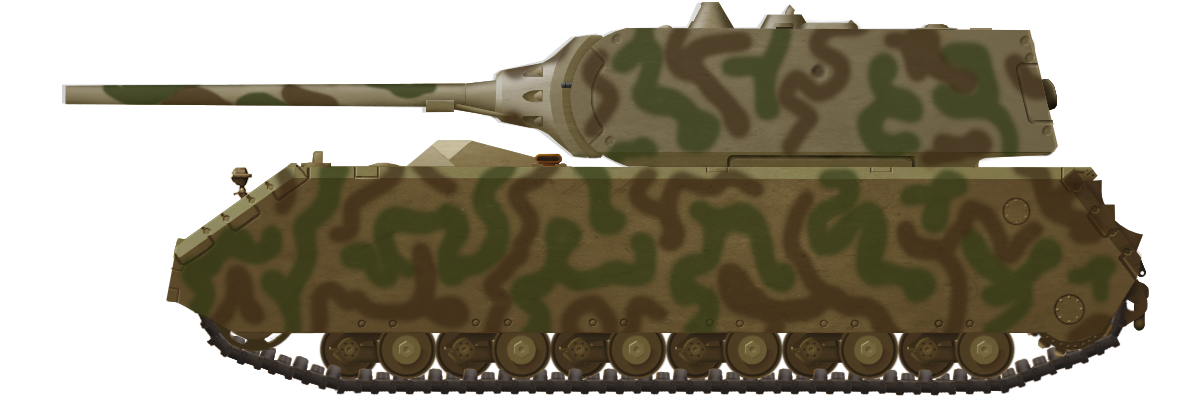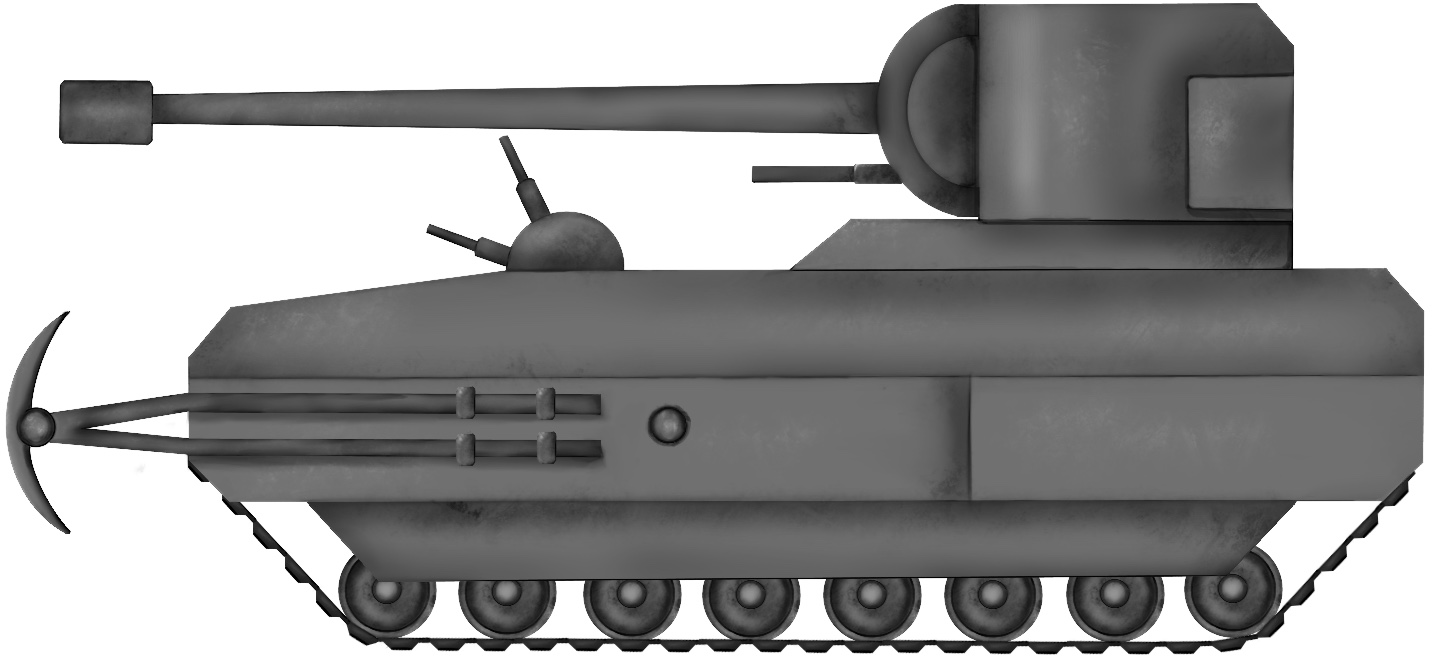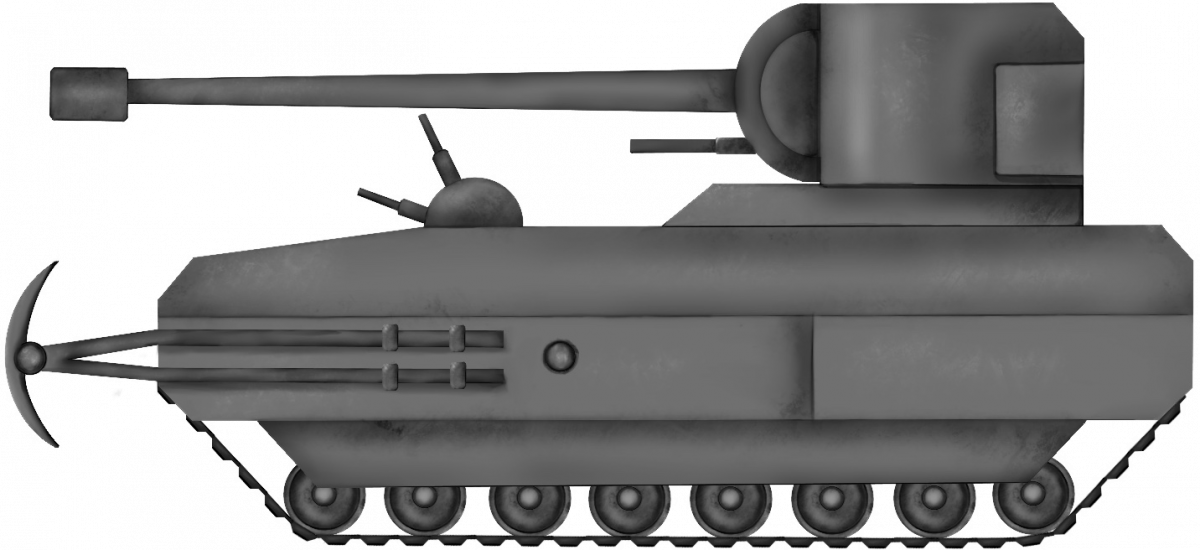 France (1956)
France (1956)
Tank – Patent Only
Post-World War Two Europe was a continent rich in the legacy of the war. A legacy which took the form of an abundance of tanks, both in the form of legacy leftovers of the war, and a ready supply of new tanks from Britain (Centurion) or the United States (M47). The only thing matching this ready supply of tanks was an absence in the availability of foreign capital with which to purchase new tanks.
Yet new tanks were needed. The French had the remains of an empire to defend and there was also the very real threat of the powerful Soviet Union to the east, occupying much of what was left of Eastern Europe and Germany, along, of course, with the emergence of nuclear weapons.
Into this strategic mess of bankruptcy, an attempt to reassert an old order, and a new and assertive European land power, came the unassuming George Giacomini. In 1956, Giacomini submitted his concept for what was needed: a modern tank for these new and most dangerous times; a multiturretted, front-engined giant capable of preparing its own defenses. Whilst his design was not practical and was never built, it serves to illustrate one of the few ideas for new battle tanks in Europe at this time.
Novelty
The point of patents is to protect an element of novelty. Ergo, something new to an existing item or product or system. The novelty at play in Giacomini’s design was not strictly just the tank, although it is an odd design for the time in its own right. Instead, the novelty was that this tank should be equipped, as standard, with trench digging/earthmoving equipment with which it could provide its own defensive structure. The fact that he decided to show it on such an odd platform, one so out of keeping with the tank trends prevailing for in-service vehicles of the time, was perhaps the most novel aspect of the whole design.
The Man
Georges Giacomini is also an enigma. His location on the patent application was Bouches-de-Rhône, an area on the south coast of France, close to Italy, where there was a significant Italian population. His nationality is not given as ‘Citizen of the Republic of France’, but, instead, as a “residant en France” – in other words, merely living in France and not French.
The only additional clue is also a patent. In March 1974, a man called Georges Giacomini, a resident of ‘Quartier Bel-Air 13300 Salon de Provence’ applied for a patent in France for a type of power generator using water pressure. That patent was granted in 1975. This location is within the province known as Bouches-de-Rhône. Whoever he was, whatever his background or nationality, he appears to have remained in the area for some time and continued to put his mind to ideas of technology and engineering, even if his tank never left the patent office.
The Tank Described
Giacomini provides no dimensions for the tank, but it is clearly a large vehicle. Suspension consisted of 8 road wheels on each side supporting a high track run, presumably running on some return rollers under the side plates out of sight.
The engine and automotive elements which are undescribed would clearly be fitted into the front of the vehicle, leaving a space at the back on which to mount the turret with the primary armament.

Source: French Patent FR1151425
Note: image has been digitally cleaned by the author.
The body, large and cumbersome, is taller than most tanks, with the bulk of the hull rising above the level of the track run. The front of the tank is not sharply angled to meet the glacis but instead comes up vertically until it is level with the top of the tracks. After this vertical section it is followed by a short nose angled back at around 45º before the sloping glacis begins. This glacis extends back to a point level with around the second road wheel at around a 25º angle before meeting the flat top of the hull.
Immediately behind the intersection of the glacis with the hull top are a pair of small hemispherical turrets. Behind these mini turrets, the hull roof is flat covering an area under which can only be assumed to be the engine and other power components, vents, radiators, etcetera, needed to move the vehicle.
On the back half of the hull is a raised platform with a sloping front on which the main turret (carrying the primary armament) is mounted. This section is actually misdrawn in the plan view of the patent where the primary gun is shown in the plan-view as protruding from the front of the platform rather than the turret itself. The side elevation view is much clearer showing the gun attached to the turret instead.

Source: French Patent FR1151425
Note: image has been digitally cleaned and altered by the author.
The turret itself is of a well rounded form in plan view but which has vertical sides all round. The front slopes back from the rounded mantlet presenting a small and well shaped profile to an enemy vehicle. On top of the turret is a large square hatch and another square hatch is drawn on the rounded rear of the turret.
The back of the hull has the same 45º angled short ‘nose’ from the front, before becoming a vertical flat back plate. Over the vertical sides of the vehicle are a set of side skirts covering the running gear just just below the top of the road wheels.
It is onto these side skirts that the clever digging gear devised by Giacomini is attached.
Armament
Regarding the arrangement of the tank with its tall hull and mini turrets half-way down the length of the body, it is unclear if these turrets were just there for show in the patent, or if Giacomini genuinely thought these might be useful. Their placement certainly allows for depression of their guns down over the glacis to fire forwards, covering the blindspot which might otherwise be a problem in a rear-turreted tank, but Giacomini put the rear turret’s main gun so high up that it could itself depress to cover the same area. Quite what benefit these mini-turret guns could add is unclear. They are not drawn as some small gun either, like a machine gun, but something more akin to a small caliber cannon. As previously stated, the arrangement shows a vehicle with the engine and transmission-type components in the hull front and/or middle, so these turrets would potentially be crewless in order to save space inside for the machinery.
The gun in the primary turret is unusual in its own right. The curved mantlet is more than simply a protective cover over the front of the turret. Here, instead, the mantlet is also a mount for the gun itself. Formed in a circular shape, the mantlet is a letter ‘C’, with the breech of the gun attached to the base of the open face of the ‘C’ and then poking out through the back of the letter. With the trunnions, the bearings and point about which the whole piece rotates, in elevation mounted centrally within the ‘C’. The whole affair rotates as a wheel around a much larger arc of rotation than with a normal type of gun mounting, both in elevation and depression. Control of this rotation is done by means of a planetary gear affixed to the turret which engages with gearing on the mantlet to cause it to rotate up to “90 [degrees] with absolute accuracy”.

Source: French Patent FR1151425
Note: image has been digitally cleaned by the author.
The patent clearly explains that the turret is expected to be able to rotate around a full 360º. With this gun mounting system as previously described, the vehicle is thus able to provide fire around a substantially wider area than a conventional vehicle. The primary gun is not identified or speculated about. However, the secondary gun is described and known to be an undisclosed type of heavy machine gun. This gun was not only for engaging targets in its own right but was also intended as an aid to aiming of the main gun.
Entrenching
The primary purpose of the patent, and rather overshadowed by the tank he provided as a carriage for it, was the earthmoving blade. This was no mere bulldozer blade. Such things had already been in widespread use for years, and Giacomini’s vision for an improvement was something quite different. Shaped in the manner of a half-moon in profile, his blade curved inwardly towards the vehicle unlike a conventional blade which curves away from the vehicle to act as a scoop.

Source: French Patent FR1151425
Note: image has been digitally cleaned by the author.
The purpose of this earthmoving device was specifically for mobile and static use, something a normal type of blade could not do. In motion, the power of the vehicle could be used to push with the blade, but also, by dropping it, to scrape out an entrenchment for the vehicle.
When static, the same could still be done. I.e when the tank might have stopped to engage in combat it could deploy its entrenching device to build up earth or debris in front of the hull to help provide additional protection.
The way this worked was by virtue of the mounting system. On a conventional blade, it is usually attached to either mounts on the front of the tank, or onto pivots on the side and can be moved hydraulically. It operates just as a ‘pusher’ to move earth in front of it. On Giacomini’s design, the vehicle, even when stationary, could rotate the large mountings on the side skirts to lower the blade. The blade itself, mounted on a pair of horizontal tubes attached to that large mount could then propel the blade forwards as it gets dropped onto the ground, and then retract it back towards the vehicle to create a scrape in front of the vehicle. By repeating this extend/drop, retract and scrap technique several times the vehicle could thereby create a substantial berm in front of itself for protection.
Conclusion
The patent is surprisingly brief, at just 3 pages long. For such a complex device of earthmoving equipment, or the unusual gun mounting system, a longer description might normally be expected. In fact, he provides so much visual information in terms of the drawing of the tank and an unnecessary addition of those mini-turrets on the hull that it overshadows both of the really innovative elements and for no additional benefit.
As a tank, the design is certainly unusual. Front engine tanks were not new, there had been designs prior to Giacomini’s in 1954. Probably the most famous of these, and a vehicle with an equally hefty and brutalistic hull shape, was the German Maus. Giaocomini’s design of a tank is somewhat annoyingly vague on technical details despite him clearly having given some thought to layout and how a vehicle could work in combat. The ability to fire the tank’s main gun vertically and the ability to dig itself in were things nobody else had managed prior to that date, and yet those mini-turrets were a retrograde element in the design, adding no combat power and replacing them instead with added complexity, cost, crew, and weight.

As drawn and described the tank offered little for militaries. The lack of detail and the ‘regression’ to an earlier era of tanks with multiple turrets was unlikely to find interest. As such, the design stayed a patent and appears to have been quickly forgotten.

Giacomini Tank Specifications Giacomini Tank |
|
|---|---|
| Crew | u/k |
| Dimensions | u/k |
| Armour | u/k |
| Armament | one primary gun and coaxial gun, two mini-turret |
| Engine | u/k |
| Speed | u/k |
Sources
French Patent FR1151425, Disposif de terrassement adapte a un char de combat. Filed 14th June 1956, granted 19th August 1957, published 30th January 1958.
French Patent FR 7411006, Disposif generateur de puissance. Filed 26th March 1974, granted 24th October 1975.

